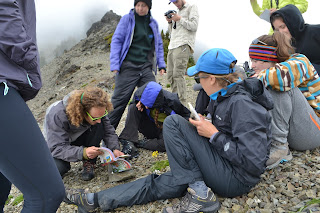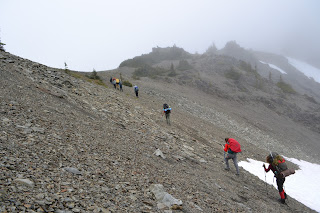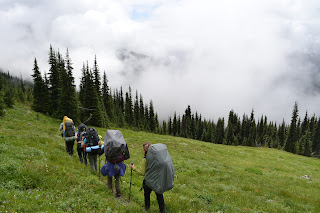by Hailee Herbst & Minji Jung
This morning, we were awoken by our trusty alarm clock, Kramer. Though our usual wake up time was about 7 am, we were rousted a bit earlier at 6 am for the long day ahead. Yesterday had been an especially challenging yet rewarding day, after crossing an insane snow pass and navigating through steep off-trailing. I felt like our whole group had really bonded after experiencing those demanding moments together, and the new energy was palpable.
We started off the morning with an exciting finding--ice worms! Tim (aka The Ice Worm) and Kramer set out late last night after we failed to find any during the daytime. Apparently, ice worms are more likely to wiggle to the surface and readily be found at nighttime (with a lack of bird predators about, and a lack of damaging UV rays). We passed around chunks of snow with small, thin, black ice worms about half an inch in length. Aesthetically speaking, ice worms are not particularly marvelous--they are so small it is easy to mistaken them as floppy pine needles. However, as Tim explained the background and history of ice worms, their presence in the Olympics became that much more precious and interesting.
The ice worms in the eastern part of Olympic National Park originated from Alaska during the last ice age. Ice worms are only found in glaciers, often deep below surface. However, as global climate change is altering landscapes such as the Olympic National Park, many glaciers are shrinking and outright disappearing. These rapid changes has resulted in considerable habitat loss for ice worms--and this trend is only expected to continue, if not intensify in the coming decades. Learning about the history of ice worms in the Olympics was one prime example of how our class examined global climate change in action and witnessed its impacts on species right before our eyes. And so, the discovery of a few ice worms at Gray Wolf Pass provided a sweet sense of relief and excitement for our whole class. It provided evidence that glaciers are still intact and gave us a special opportunity to experience and enjoy a species that may be increasingly difficult to find in future generations.
 |
| Ice worms ahoy! Tim and Kramer ventured out after dark to find these little glacier dwellers. |
 |
| Compared to yesterday, crossing these snow passes felt like a breeze! |
We made our way to Gray Wolf Pass after our hike up the mountainside. We had a long day of hiking ahead of us where we'd cover well over 7 miles, so naturally we stopped on the pass for about an hour and a half. While up there, we geeked out over some new plants we hadn't seen yet and marveled over the rock formations. The rocks were being pushed up out of the ground in paper thin sheets, crumbling and cracking at the slightest touch. We could pull pieces of rock out of some of the larger build ups, sliding them out like books out of a bookshelf. They were stained all sorts of colors and were really beautifully delicate. We all took some time to try to identify the flowers we were looking at while the wind whipped over the pass. The clouds were covered a majority of the view beneath us, but we could still see the mountains around us.
 |
| Kramer consults the handy flower guide to identify new species at the top of the pass. |
 |
| Cut-leaf daisy, a typical alpine mat-forming species. |
 |
| Silky phacelia |
 |
| Rock stripes forming. |
 |
| Eriogonum ovalifolim, aka cushion buckwheat, similar to the Eriogonums of eastern Washington's desert country. |
 |
| Elephant head |
 |
| Moments before this picture, I'm almost positive we were collectively belting, "The hills are aliiiive, with the sound of muuuusic!" |
 |
| How lucky are we!?! The stunning Dosewallips River valley with Mt. Deception and Mt. Mystery in the background. |
 |
| Entering gorgeous silver fir and old western hemlock forests as we move up valley.. |
At lunch, we marveled at the sight of the sun and ripped off our wet boots and soggy socks. We set them in the sun to dry out, lazily enjoying the patches of sun that hit our group. This was the first time our boots had a solid chance of drying in the past 2 days, so we embraced the moment and hoped for the best. Soon after leaving our spot, we had our first emergency. Madeline somehow ended up in the ditch next to the trail, tweaking her knee in the process. She still isn't sure what happened, but Tim and Kramer fixed her up and she hobbled onwards with no complaints like the trooper she is. We don't call her Madeline "bad boy" Kernan for nothing.
The hike today was over 7 miles, but it went by fast and sun was out doing its thing. For the last two miles, we had a solo hike so that we would enter Dose Meadows one by one. This was my favorite solo hike of the trip. First, I would be wandering through a forest with completely new ground and tree species from the forest area before, and then I would find myself in a vast meadow with great mountain ridges peaking in the background. There was so much diversity and beauty within that short two mile hike.
I was marveling at a forest full of silver fir trees, one of my personal favorites, and then soon arrived at Dose Meadows. When I first stepped into the meadow, I wanted to giggle, cry, hug the grasses, shout with amazement, and frolic all at once. Its difficult to describe the beauty and feeling of the place. After camping out at chilly Gray Wolf Pass and hiking through the harsher alpine environment, arriving at Dose Meadows felt like coming home. It was warm, lush, and inviting.
 |
| Down through the meadows into the Dose valley. |
After dinner, Jacob led a really relevant discussion on how Seattle's growing population would affect the city and the surrounding national parks. He laid out a brief history of Anthropogenic landscape change in the Puget Sound region and then used the Seattle 2035 plan to frame our discussion. One interesting topic was the 2035 plan's focus on equal opportunity for minorities and people of low socioeconomic status. We discussed how intimately the environment and land is tied with issues of inequality and racism, from colonization and stealing of Native lands 400 years ago to gentrification and increasing rates homelessness today. We talked about how important it is for us to live in spaces of diverse people and perspectives. We also discussed how to incorporate the growth of Seattle with the preservation of the green spaces in the area. It's difficult to find places to fit everyone without creeping into some of the beautiful, wooded areas of Seattle. Thus it is crucial, to prevent sprawl and congestion, to maintain affordable spaces for all within the city--and to create a good system of public transport.
 |
| An alpine phlox. |
 |
| Silky phacelia |
 |
| Cushion buckwheat |
 |
| Nearly all the krummholz subalpine fir above tree line this year was infested with a budworm. |
 |
| Deer lounging in meadow coming down from Gray Wolf Pass into the Dose valley. |
Hailee: Reflection
I had never backpacked before, and quite honestly I had no idea what I was getting myself into when I signed up for this class. I've always loved hiking and being outdoors, and I was excited about the opportunity to really get into the thick of things with this class. This trip exceeded every expectation I had. I was so amazed at the beauty I was surrounded by and the way our group worked together so perfectly.
I miss so many things about the Olympic National Park already. Oddly enough, something I really miss are the smells that accompanied the places we were in. Hiking through meadows, old growth forests, rocky peaks, and everything else, we were constantly drenched in new smells that have no city equivalent. Everything was fresh and clean, thick with the environment we were in. I also really miss the quietness of our trip. There were moments where you could hear nothing but soft winds blowing and birds chirping from a distance away. Occasionally, a marmot would scream. When I came back to Seattle after our trip, I was so aware of how loud this place is. Cars are constantly honking and doors are slamming shut and people are talking and yelling. There's a constant buzz in a city that eventually blends into the background of our lives. The contrast from the peaceful silence of the park to the busy sounds of the city made me crave a silent meadow.
This trip shook up my way of thinking about wilderness a bit. I had always thought of wilderness as a very pristine, perfect landscape that had no human interaction. These pictures of wilderness I had in my mind were far removed from civilization, untouched. Now, after this trip, I see that wilderness is all around us. The parks in Seattle are wilderness. The areas that surround Seattle are wilderness. The places I've hiked with friends and thousands of other city dwellers are wilderness. When we expand our idea of wilderness, I think it becomes much easier to understand how important wilderness is. It is not this far-off concept that only affects mountain goats and marmots; it is a topic that we must think about for the sake of our own lives. Wilderness preservation is so important and the way we tackle that topic will drastically change the outcome of the places we live and the beautiful areas in our country that we're able to save from further exploitation. I'm so thankful for all of the discussions we had on this trip because it really gave me a holistic view of what can and should be done for wilderness preservation in our lifetime.
Minji Reflection:
When I look back to the trip that seemed so long ago, the
solo times are what stands out. (Not that I don’t love all of my trail
buddies!) Taking the time to sit and “be with a tree” on the second day of the
trip was perhaps the first time that I ever truly felt a part of nature. So
often, I romanticize misty forests and picturesque mountain landscapes, and
only experience wilderness as a lucky visitor or photo-taking observer. Even
when my feet venture from the path, my mind stays on the path. In my own world
at home, there is a clear divide between the living, urban sphere and the
wilderness sphere I frequent every occasional weekend. But being so alone,
silent, and intentional in that forest transformed how I saw my place,
proximity, and purpose in wilderness. I remember feeling fear as I blundered
away from the path and into the dimly lit forest, panic as my face staggered
through a spider web, and an unappetizing feeling when my hand grazed a rubbery
fungus. But then I sat. Stared. Breathed. And the hyper-vigilance I felt
towards the forest slowly melted away into breathless wonder and delight.
Clingy black fungi transformed into perfected, miraculous saucers and mundane
moss morphed into soft, luscious clouds of greenness. The longer I sat, the more
I saw and the comfortable I felt. It felt so natural to sit in quietness, surrounded
not by the mysterious unknown, but by beauty, stillness, and life.
The
wilderness experience has definitely shown me that I am a part of nature and
wilderness. I am only a visitor of wilderness if I choose to be. I have been
grappling with what implications this simple truth has on the way I live and
interact with nature. I no longer view wilderness experiences only as a fun,
recreational activity, but as an undeniable necessity that is lacking in modern
societal life. We grow from the land, and there is an essential part of us that
longs to be in fellowship with it. Studies show the immeasurable mental health
and health benefits of simply being outside in green spaces. But on an even
simpler level, I know how we feel and think and see and move differently after
being in nature. Backpacking through wilderness areas provided the time and
space to appreciate and interact in a mutual way with nature. One of the most
implications from this mutual interaction is the greater sense of
responsibility and respect for wilderness areas. I realize that I must have a
greater responsibility to the Earth, particularly to the land of Seattle,
starting with how I eat, move, recreate, and produce waste. I am increasingly
more aware of how my daily actions can contribute or dismantle systems of
exploitation. After this trip, I am convicted to be a better steward of this
Earth that I both love and need.
I realize
what a privilege it is to experience wilderness—how our society is set up in a
dichotomous way that unfortunately creates a divide between urban life and
wilderness. As the trip went on, I felt more and more lucky, almost guilty,
that I was here in the Olympics to experience all this, while my family and
friends didn’t have that same opportunity. Coming back to rhythms of daily
life, I am more convinced that national parks must become more accessible and
inclusive to people of all different races, cultures, and socioeconomic
statuses. While there are important discussions to consider on limiting human
impact and preserving wilderness, the parks also need to make greater efforts
to engage populations historically denied and excluded from wilderness spaces.
Sentinel
peak was one of my favorites of the trip. The 360° sight was insanity. Being
surrounded by the grand mountain ridges, sloping valleys, and sprawling meadows
made feel so small. I felt humbled to be just one human in this beautiful land
of life and biodiversity. I couldn’t help but crinkle my nose at all of the
miniscule and fleeting nuisances I fret over in Seattle. Journeying through
this trip has also given me a unique confidence that I have never afforded
myself. Looking at the vast landscape and locating where we were just a day ago
was incredible to think about, and it empowered me to realize that I am
stronger and more powerful than I think.
But at the
same time, I began to understand how weak we humans are, after being in
wilderness for nine days. There is such a narrow margin of temperatures that I
can survive in, such few weather patterns I can power through without Gore-Tex,
and only so far I can walk before my feet blister. I realize how obsessed we
are with cleanliness and sterilization in modern society. I was perpetually
sweaty and dirt-caked, my dinners always had some wilderness sprinkled in, and
I never used soap—yet here I still stand! I am way more tolerant of my food falling
on the ground or taking fewer showers. Its less waste, the way I see it!
One of the
sweetest times of the trip was when we were all on the top of Sentinel peak
together. We were quiet because it was journaling time, but we were all
slouched in a cluster together, with the wind blowing hard and the sun beating
down. Some of us were drawing, writing in the dirt, munching on Wasa, looking
pensively across the landscape, or even napping. It seemed the most natural
thing in the world that we would all be casually lounging together on this
mountain peak, surrounded by the most beautiful sights and so far from civilization. It
felt so effortless to click and be in fellowship with everyone on this
trip.
A huge
takeaway from this trip is how important stories are. Learning the history of
old growth forests or the Latin names of small, springy wild flowers has given
me a greater knowledge of wildlife and more matured respect for wilderness
spaces. Hearing my fellow trail mate’s life stories, struggles, and thoughts
also reminded me of how powerful storytelling can be. I have learned so much
about this group—the sweet details and funny quirks of people I normally
wouldn’t think twice about. This class lumped together twelve very different
people, but the journey through the Olympics brought us together in ways that
are so unique in today’s society. I am so so thankful, and I'm eager to keep
sharing stories to increase knowledge and love of wilderness and also learn
from the lived experiences of buddies around me.
 |
| Scarlet paintbrush, a root parasite with red bracts (pseudo petals). |
 |
| Ants tending aphids on a plant in the meadow. The ants protect the aphids, and the aphids give the ants a nectar reward, extruded through their abdomen. |










